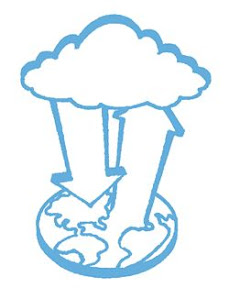This from Mary Thorpe (2009)
If face-to-face is the answer, how do you replicate the combination of informal and formal discourse opportunities that characterise the face-to-face campus. (Crook and Light, 2002)
The answer is in social networks such as Linkedin being alerted every time someone in your circle updates, or adds friends or writes something, though different, there is at least an inclining of this meeting serendipitously around the water-cooler, or passing in the corridor. Also the random offering up of 'people you might know', even if they haven't instigated it.
This is beyond face-to-face, but designed to replicate the chance encounter that makes up human intersctions.
In Diaryland (1999) a similar trait is offered as within a set number of 75 friends you always know who has updated i.e. who is active and therefore around and more inclined to engage. All that matters is this sense of sharing the same space. It matters therefore that you are present often enough to be someone in this environment and that the affordances of the platform alert others to your presence.
The debate over the differences between face-to-face are dry
Why hybrid?
What community?
As the two worlds are now so familiar to many people, this is like saying, what is the difference between the Rugby Club and the Bridge Club.
There is no other difference. The means of engagement are ultimately the same, between one person and another. Like everything as you become familiar with these platforms, and as your friends are online too, you accept their presence or otherwise as if you have bumped into them walking the dog or a conference.
This isn't revolution, it is barely even evolution, it is us being people with a bunch of different tools as we crafty humans have done for millenia.
'Technologies, such as social networking, can be used to construct personal learning environments designed by the learner precisely in relation to their interests and goals across a range of practice boundaries.(Anderson and Dron 2007)
Better still you start to allow tools like Stumbleupon and Zite to do this for you, by feeding in a specific, tailored profile you can get these aggregators to draw down who you are and feed back intelligence.
The day we don't trust it we drop these tools like a hot-potato and go somewhere else.
They CANNOT afford to get it wrong.
I signed up in error to MY LIFE, I say this because I only wanted to trial it on a monthly basis. The moment I was on the phone was the moment I was reimbursed, which actually is a sound thing.
This expression, this test of 'trust' might be enough to take me back (except that I feel the entire idea was mine in 2001).
'Technology self-evidently involves tools, understood as both the physical resources and practical skills required to make use of them, but to focus primarily on the tool or the virtual space would be to make a categorical error, mistaking a component part for the system as a whole (Jones and Eshault, 2004)
We still use pen and paper, we still talk to each other face to face, we may even share how we are getting on with our parents over Sunday Lunch.
This isn't replacement technology, it is hyper complementary technology, it is as convenient as having a hanky on which to blow your nose, no more. You pull out your smartphone to share a thought. Or in my case at 3.10am I get up, doodle an idea for a video production and then stick up a discussion question to a number of Linkedin groups.
Serendipity
Thinking of my late grandfather's garage with all its tools, the context would be the mix and combination of tools, some complimentary, some one offs, and the space (once he'd rolled the car out of the garage). Most importantly it would include him, both actively engaged in a task and from my point of view, someone who was always keen to pass on skills and insights.
Issues regarding identity -practice/familiarity
Trust and authenticity (checking/verification) 'Students may not take up the opportunities offered, or may do so to little good effect.' (Thorpe, 2008:122) 'Asynchronous conferencing for example has fostered both utopic and dystopic views of its potential (Haythornthwaite 2006)
The importance of the beginning of the course the same as in face-to-face, you only have one chance to make a good first impression.
'That particular aspect of getting everybody involved right at the very beginning really sets the scene for the rest of the course.' (Thorpe 2008:123)
Tutor as host.
A good start is forgiving. A poor start is far harder to retrieve. The problem institutionally is if your are overwhelmed by students. Are there enough tutors? Are there even intermediaries to step in? 'The design in effect performs a mix of compulsion and engineered interaction that combines formality with informality.' (Crook and Light, 2002)
Too much of either is a killer. Overly familiar and talking about pets and holidays in the middle of a forum puts your off. So do course materials on the rare occasion with The OU when it is if your are interrupting the conversation between a couple of professors who have developed their own private language that only means something to each other. (This isn't far from the truth). 'The potential for expansive learning' (Tuoni-Grohn and Engestrom, 2003)
We all want our heads cracked open like a part-boiled egg. 'This is learning that crosses the boundaries of different activity systems, expanding involvement with others and developing both individual and collective learning'. (Cole and Engestrom 1993)
I call it Pixie dust over Object 3.
Object 3 must be the moment Dyson and his team come up with the airstream device. Innovation, inspiration and originality is there in front of us, like Macbeth's dagger, tantilizingly before our hands.
So talk to Lady Macbeth and your colleagues, let it out, share your thoughts, make the dagger real, You may find it's more of a tickling stick.
'A context has to be reconstructed and participation invited through the use of activities, structured formats and textural genres operating at various levels.' (Thorpe, 2008:130)
I no longer think this is the case. We aren't creating false or mimicking landscapes or environments online, rather we know what these environments are and behave accordingly.
This comes with experience, it IS NOT, and has NEVER BEEN GENERATIONAL.
I am not the only forty something who despite my children being infront of a computer before they could walk have vastly more experience of the internet and computers than they do. I challenge them to keep up or catch up, indeed, I am quick to run after them if I think they are discovering something I too have not tried.
Ask me for evidence, research by educational institutions in the UK, US and Australia, that debunk Generation X and Digital Natives as utter TOSH.
Engestrom (2007) emphasizes the importance of learning across multiple activity systems where knowledge is being developed across many sites, from the formal academic context through practioner-focused websites and fora to the workplace.
Technologies, such as social networking, can be used to construct personal learning environments designed by the learner precisely in relation to their interests and goals across a range of practice boundaries (Anderson and Dron 2007)
True.
But like an allotment you might start as an idea, the worth comes from putting in some time and effort.
A hybrid mix of community and network. (Thorp, 2008:129)
Yes, like weeds in the allotment and a few cacti on a tray of sand in the shed.

